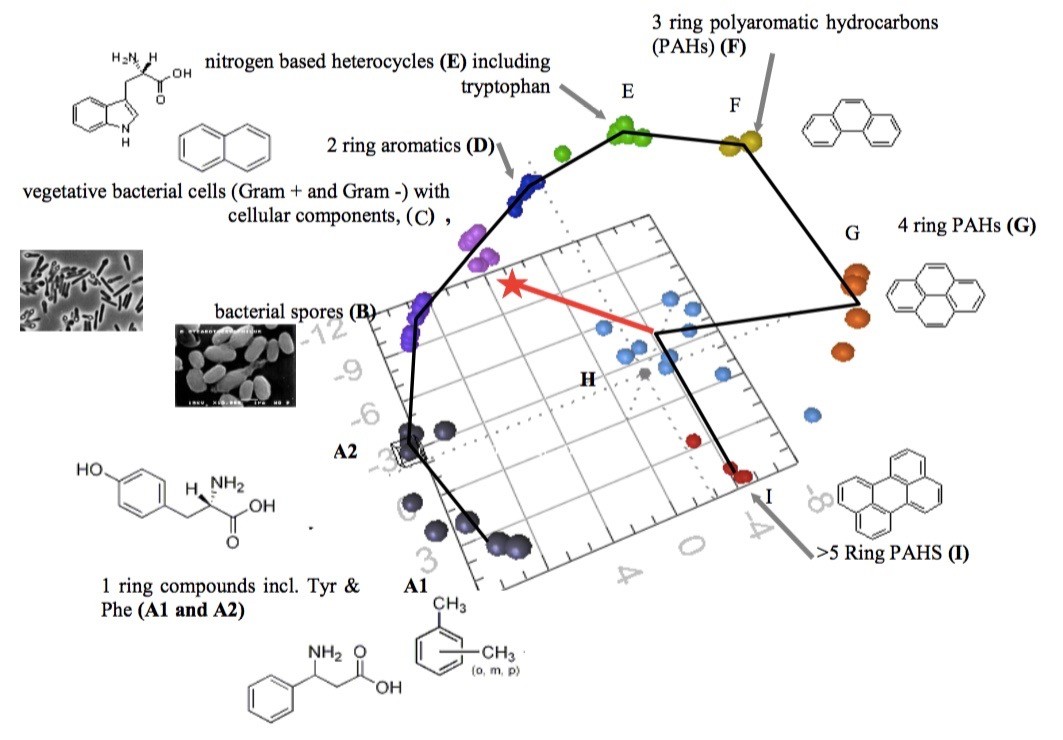Real-time, in situ, assessment of suspicious powders and substances on surfaces is an important capability needed by war-fighters and first responders. It is also important to be able to perform these assessments without contact with the suspicious substance or use of reagents.
Present hand-held surface contamination sensors predominantly employ visible or near IR Raman methods. These are not usable or highly conflicted in daylight conditions except when in essential contact with the suspicious powder and/or in dark conditions. They also are limited in the number of detectable analytes because of Raman signal obscuration by natural fluorescence within the targeted material or its surrounding material or substrate or due to low cross-sections and the likelihood of sample burning.
Also, current visible or near IR Raman sensors cannot detect or classify biological substances. Biological detection is currently limited to methods that require collection and processing of samples to be used with immunoassays or Polymerase Chain Reaction (PCR) instruments. These require bulky and expensive equipment and expensive reagents with limited shelf life and restrictive environmental conditions for storage and use.
Other hand-held sensors such as Photo-Ionization Detectors (PIDs) and Ion Mass Spectrometer (IMS) sensors detect airborne gases and vapors, which may occur because of evaporation of surface material. But they do not detect substances on surfaces which have low vapor pressure or at standoff distances. PIDs have no specificity, and IMS sensors are subject to a wide range of interferents and confusants. Except for immunoassay and PCR instruments, none of the other instruments is useful in detecting biological materials or suspicious powders of biological origin.
Photon Systems has developed hand-held, non-contact, optical method and sensors which can detect and classify trace and bulk concentrations of a wide range of chemical, biological, and explosives (CBE) materials and suspicious powders in real-time and full daylight conditions with a single, fully integrated, device. The focus of this effort has been detection of biological powders.
The low-cost handheld Biological Reconnaissance & Analysis using Non-Contact Emission- spectroscopy sensor enables detection and classification of a broad range of suspicious powders in real-time at the site of a contamination incident:
- Without the need for reagents, labels, or other consumables.
- Without contact with or disturbing the suspicious powder and the subsequent need for decontamination of the sensor or spreading, growing, or dispersing biological threats in suspicious powders.
- With rapid analysis- for each 60 μs laser pulse a full spectrum analysis is possible. Dwelling on a sample for 5 to 10 seconds can dramatically improve signal to noise of data with weak signals.
Photon Systems has demonstrated that a suspicious powder on a surface (with focus on microbial powder) can be detected and classified not only into whether is it bio or non-bio, but also what class of biological material, such as microbe, protein, or plant or skin cell, and further classified to whether the powder is a bacterial cell or spore, a yeast, a fungus, or a fungal spore, and finally, classified into the rough species of the bacteria. This can be done when diluted in talc or other inert material at up to 70,000:1, detecting as few as 5 bacteria within the sensor view.
It has also been demonstrated that this sensor can be further used to detect and classify a much wider range of non- biological material including a wide range of chemical and explosives materials. Also, it has been demonstrated that this can be done using a fully self-contained, real-time, hand-held, reagentless sensor, at a standoff distance of 5 cm to 5 meters, and shoe box sized, device weighing less than 8 pounds, including batteries for over 8 hours of typical use.
The detection method employed is deep UV fluorescence and Raman spectroscopy, excited with a miniature 248.6 nm laser, where Raman bands are separated from fluorescence emissions. This fluorescence data is collected and processed using Principal Component Analysis (PCA) where the PCA eigenvectors are iteratively trained to focus on smaller and smaller sets of the overall training data, through a 4-level triaging process.
The overall PCA training set includes a wide range of materials, including multiple examples of explosives, organic powders, inorganic materials, proteins, pollen and biological and microbial materials. It was shown that different microorganisms show measurably different fluorescence spectral characteristics. This is likely since the spectra are a result not only of the inherent chemistry within a microorganism, but also due to the conformation and configuration of that chemistry within the microorganism, and the inherent shadowing and interaction of and by the basic chemical ingredients.
In the process of this research program, the second version of the handheld Biological Reconnaissance & Analysis using Non-Contact Emission- spectroscopy sensor resulted in the benchtop, yet portable DUV Raman/PL 200 spectrometer. This system features higher spectral resolution, automated XY mapping, and other features, designed for laboratory applications

Key Issues
Detect Broad Range of Powders
Must be able to detect and identify a broad range of chemicals, explosives and biologicals.
Vapor Pressure
Must be able to detect and identify substances with low or no vapor pressure.
Solar Blind
Unrestricted daylight operation is desired.
Standoff
Standoff, non-contact operation is desired.
Downloads
DUV Raman PL 200
A fully integrated lab model deep UV resonance Raman and photoluminescence spectrometer with microscopic imaging.
TUCS 1000
The TUCS 1000 is a handheld instrument for laser based detection of trace chemicals in the fg or pg/cm2 concentration range.
STANDOFF 200
The STANDOFF 200 Analyzer is the first and only fully integrated real-time deep UV Raman and fluorescence analyzer instrument, providing complementary and confirmatory testing in a single handheld device.
Get In Touch
Keep informed about the latest deep UV developments at Photon Systems by joining our mailing list.
ADDRESS
1512 Industrial Park St. Covina, CA 91722-3417
PHONE
626 967-6431



